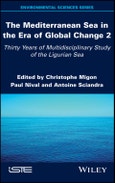As such, 30 years ago, an offshore time-series site provided a fresh impetus to a long history of marine biology research, which has generated a very important body of data and knowledge. This is the second volume, in a two-volume series, that summarizes this research. Across these two books, the reader will find 13 chapters that examine the geology, physics, chemistry and biology of the Ligurian Sea ? always with the goal of providing key elements of oceanography in a changing world.
Table of Contents
Preface ix
Chapter 1. Dissolved Organic Carbon Dynamics in the Ligurian Sea 1
Chiara SANTINELLI
1.1. Introduction 1
1.1.1. Why dissolved organic carbon? 1
1.1.2. Why dissolved organic carbon in the Ligurian Sea? 3
1.2. Dissolved organic carbon vertical distribution in the Ligurian Sea 5
1.3. Dissolved organic carbon temporal variability at the DYFAMED station 8
1.3.1. Seasonal variability in the upper 50 m 10
1.3.2. Dissolved organic carbon stocks (0-50 m) 12
1.4. Dissolved organic carbon surface distribution 12
1.5. Chromophoric dissolved organic matter 15
1.6. Carbon export to depth 16
1.6.1. Winter mixing 16
1.6.2. Deep-water formation 17
1.6.3. Particulate organic carbon export 19
1.7. Dissolved organic carbon stocks and fluxes 20
1.8. Main remarks and future directions 22
1.9. Acknowledgements 24
1.10. References 24
Chapter 2. Dynamics and Export of Particulate Organic Carbon (POC) 31
Beat GASSER, Scott W. FOWLER and Juan-Carlos MIQUEL
2.1. Historical developments of POC flux studies 31
2.2. POC in the Ligurian Sea 35
2.2.1. Carbon biogeochemistry 35
2.2.2. Export flux, key contributors and processes 42
2.2.3. Modeling POC dynamics 52
2.3. Present status of POC flux and dynamics in the Ligurian Sea 54
2.4. References 57
Chapter 3. Zooplankton I. Micro- and Mesozooplankton 67
John DOLAN and Virginie RAYBAUD
3.1. Introduction 67
3.1.1. Defining plankton and the different categories of plankton 67
3.1.2. Problems with the label zooplankton 71
3.2. Ligurian zooplankton 73
3.2.1. Introduction to microzooplankton and mesozooplankton 73
3.2.2. Sampling 75
3.3. The ciliate Strombidium sulcatum and the microzooplankton of the Ligurian Sea 78
3.3.1. Strombidium sulcatum 78
3.3.2. Characteristics of the Ligurian Sea assemblages of ciliates 80
3.3.3. Seasonal cycles of abundance of ciliates in coastal water 82
3.3.4. Near-shore to off-shore abundance gradient of ciliates 83
3.3.5. Seasonal variability in abundance of ciliates in off-shore waters and the depth gradient 84
3.3.6. Non-ciliate components of the microzooplankton of the Ligurian Sea 86
3.4. The mesozooplankton of the Ligurian Sea and the copepod Centropages typicus as a case study 89
3.4.1. Presentation of mesozooplankton and ecological role 89
3.4.2. Characteristics of the Ligurian Sea assemblages of crustacean zooplankton 91
3.4.3. Centropages typicus, a dominant copepod species in the Ligurian Sea 95
3.5. References 99
Chapter 4. Zooplankton II. Macroplankton and Long-Term Series 109
Paul NIVAL, Fabien LOMBARD, Janine CUZIN, Jacqueline GOY and Lars STEMMANN
4.1. Macroplankton: the large planktonic animals 109
4.1.1. Overview of the size class 109
4.1.2. Mollusks (Gastropoda) 110
4.1.3. Annelids 112
4.1.4. Chaetognaths 113
4.1.5. Planktonic prochordates - tunicates 114
4.1.6. Cnidarians 119
4.1.7. Ctenophores 124
4.2. Micronekton 126
4.2.1. Euphausiids 126
4.2.2. Other micronekton species 129
4.3. Zooplankton long-term series 131
4.3.1. Introduction 131
4.3.2. Zooplankton temporal trends in the Bay of Villefranche-sur-Mer as an indicator of Ligurian Sea dynamics 132
4.3.3. From local variability in plankton to global understanding and plankton community forecasts 136
4.4. References 136
Chapter 5. Climate Change Effects on the Ligurian Sea Pelagic Ecosystem. What About Top Pelagic Predators? 147
Maurizio WÜRTZ and Jean-Marc FROMENTIN
5.1. Introduction 147
5.2. Top pelagic predators in the Ligurian Sea. What about species and what we know about their responses to local climate change? 148
5.2.1. Squids 149
5.2.2. Bony fishes 152
5.2.3. Sharks and rays 159
5.2.4. Sea turtles 161
5.2.5. Marine mammals 162
5.3. Conclusion 164
5.4. Acknowledgments 165
5.5. References 166
Chapter 6. A Biogeochemical Approach to Contamination of the Ligurian Sea 175
Daniel COSSA, Scott W. FOWLER, Christophe MIGON, Lars-Éric HEIMBÜRGER-BOAVIDA and Aurélie DUFOUR
6.1. Introduction 175
6.2. Trace metal contamination 177
6.2.1. Impact of atmospheric deposition 177
6.2.2. Mercury 179
6.2.3. Tributyltin (TBT) 184
6.3. Radionuclides fluxes 185
6.4. Organic chemical contaminants 189
6.5. Contamination of the LS in the context of the global change 193
6.6. Acknowledgments 198
6.7. References 199
Conclusion and Perspectives 207
Acronyms 221
Glossary 225
List of Authors 243
Index 245
Summary of Volume 1 247








